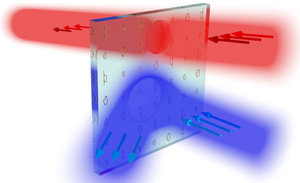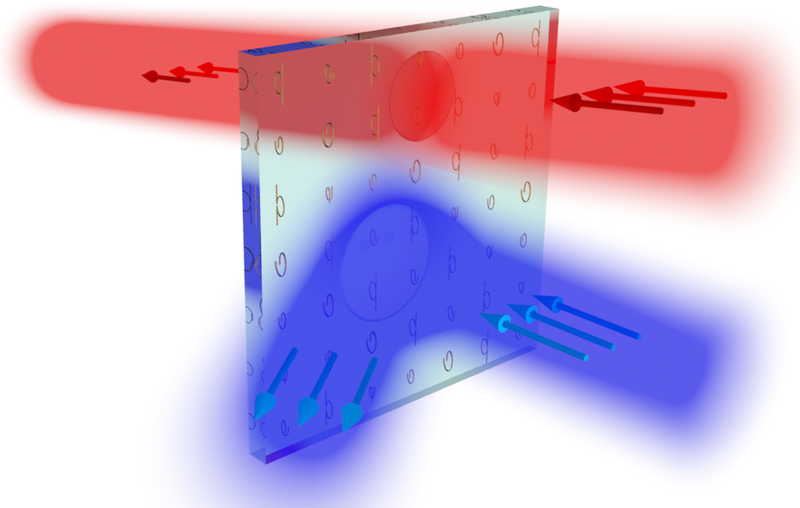Single-Frequency Mirror
Ordinary mirrors reflect light over a broad range of frequencies, but a new mirror design can reflect a single frequency while allowing all others through. This “metamirror,” an array of subwavelength pieces of shaped metal embedded in a transparent medium, can also be made to reflect light in a chosen direction or focus it like a curved mirror. Flat metamirrors could replace dish-shaped receivers, or they could cover satellite solar panels and allow sunlight through while reflecting microwave communication signals.
Mirrors are typically flat, metal-coated sheets that reflect all incoming light waves at an angle that is equal but opposite to the incident angle. Researchers have, however, created thin, structured sheets that, when placed over a normal flat mirror, disturb the passage of light and cause it to be reflected at any desired angle [1]. Often, these structured surfaces are made of metamaterials—engineered materials with complex structures at scales smaller than a wavelength of light.
All of these metasurfaces have relied on an underlying metal surface for the reflection, but Sergei Tretyakov of Aalto University in Finland and his colleagues realized that a metasurface can reflect light all by itself. Taking away the conventional reflector makes the metamirror transparent to all but a selected range of frequencies, whose reflections can be controlled to a large degree, says team member Viktar Asadchy of Aalto University and Francisk Skorina Gomel State University in Belarus.
The researchers designed a metasurface for microwaves, but they say the same concepts could be applied to a visible light mirror. The thin metamirror is made of millimeter-sized metal components embedded in a microwave-transparent medium. The components, a combination of straight copper wires and loops, are called “omega inclusions” because many of them look like the Greek letter omega (Ω). When a microwave with the resonant frequency (determined by the size of the omega inclusion) strikes the metamirror, it generates currents in the wires and loops, and they, in turn, re-emit, or scatter, microwaves at the same frequency. The shape of the inclusion affects the phase of the scattered microwave light—the timing of its wave crests in relation to the incoming light—and the net effect of the right combination of shapes is to reinforce one specific direction for the scattered waves.
The team’s metasurface design includes a variety of inclusion shapes, placed in a two-dimensional geometric pattern. The inclusions all respond to the same frequency, allowing other frequencies to pass through unaffected. Using computer simulations, the researchers showed that they could design an array that completely reflected an incoming light wave at any angle they wished.
To verify their design, the group constructed strips of metamirror containing a single string of omega inclusions and exposed them to microwaves at the resonant frequency of 5 gigahertz. In the first demonstration, a strip with six different omega inclusions in a linear pattern reflected 90-degree-incident microwaves at a 45-degree angle.
In a second demonstration, the researchers created a focusing mirror using a radially symmetric pattern of omega inclusions. They showed that plane waves hitting the flat structure will bounce off and focus to a point, as if the mirror were curved. The team imagines this sort of metamirror could replace parabolic dishes on satellites, which can be expensive to build and deploy. A layer of omega inclusions could be placed over a flat solar panel, creating a multifunction surface that focuses microwave signals into a receiver, while still letting visible and infrared light through to the solar cells. In radio astronomy, multiple “dish-like” layers could concentrate different frequencies onto separate receivers, thereby obtaining multiple measurements with a single flat structure.
“The concept seems very impressive to me,” says Filiberto Bilotti of the University of Rome III. Previous work had shown that thin metamaterials could manipulate transmitted light, he says, but the manipulation of reflected light “represents a significant breakthrough.” Andrea Alù of the University of Texas at Austin says this use of subwavelength inclusions pushes the limits of light-wave manipulation. One drawback he foresees, however, is that the resonant nature of the metamirrors could make their performance quite sensitive to variations in the frequency of incoming radiation.
This research is published in Physical Review Letters.
–Michael Schirber
Michael Schirber is a Corresponding Editor for Physics Magazine based in Lyon, France.
References
- N. Yu and F. Capasso, “Flat Optics with Designer Metasurfaces,” Nature Mater. 13, 139 (2014); A. Pors, M. G. Nielsen, R. L. Eriksen, and S. I. Bozhevolnyi, “Broadband Focusing Flat Mirrors Based on Plasmonic Gradient Metasurfaces,” Nano Lett. 13, 829 (2013)





